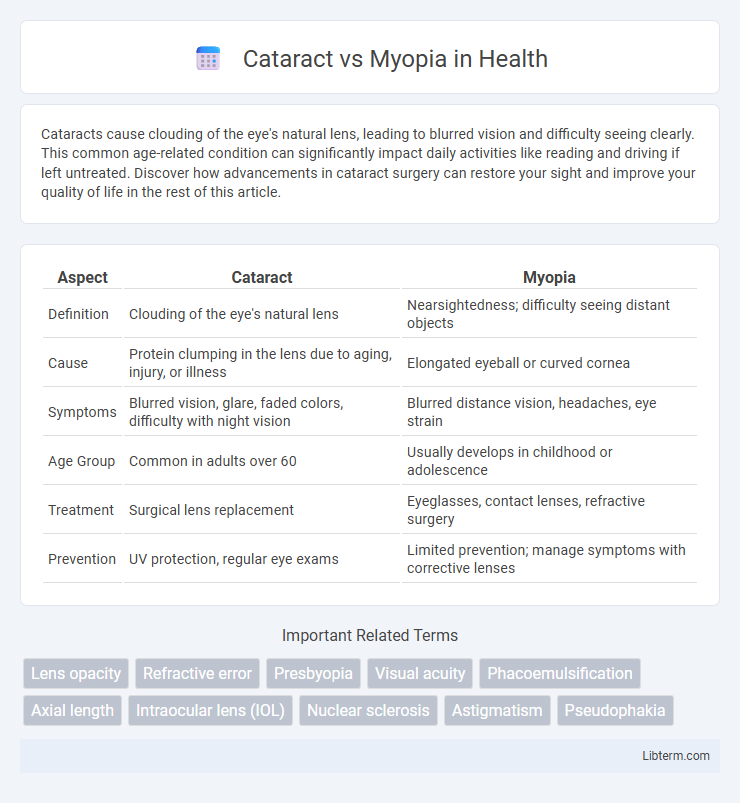Cataracts cause clouding of the eye's natural lens, leading to blurred vision and difficulty seeing clearly. This common age-related condition can significantly impact daily activities like reading and driving if left untreated. Discover how advancements in cataract surgery can restore your sight and improve your quality of life in the rest of this article.
Table of Comparison
| Aspect | Cataract | Myopia |
|---|---|---|
| Definition | Clouding of the eye's natural lens | Nearsightedness; difficulty seeing distant objects |
| Cause | Protein clumping in the lens due to aging, injury, or illness | Elongated eyeball or curved cornea |
| Symptoms | Blurred vision, glare, faded colors, difficulty with night vision | Blurred distance vision, headaches, eye strain |
| Age Group | Common in adults over 60 | Usually develops in childhood or adolescence |
| Treatment | Surgical lens replacement | Eyeglasses, contact lenses, refractive surgery |
| Prevention | UV protection, regular eye exams | Limited prevention; manage symptoms with corrective lenses |
Understanding Cataract and Myopia: An Overview
Cataract is a clouding of the eye's natural lens leading to blurred vision, primarily caused by aging, trauma, or medical conditions such as diabetes. Myopia, or nearsightedness, occurs when the eye elongates or the cornea curves too sharply, causing distant objects to appear blurred while close objects remain clear. Understanding the distinct causes and symptoms of cataract and myopia is essential for proper diagnosis and treatment, with cataract often requiring surgical removal and myopia commonly managed with corrective lenses or refractive surgery.
Key Differences Between Cataract and Myopia
Cataract is an eye condition characterized by the clouding of the lens, leading to blurred vision and light sensitivity, whereas myopia, or nearsightedness, is a refractive error causing difficulty in seeing distant objects clearly. Cataracts typically develop due to aging, trauma, or medical conditions like diabetes, while myopia is often inherited or caused by excessive eye strain and environmental factors. Treatment for cataracts involves surgical removal of the cloudy lens, whereas myopia is managed with corrective lenses or refractive surgery.
Causes of Cataract vs. Causes of Myopia
Cataracts develop primarily due to aging, oxidative stress, diabetes, prolonged UV exposure, and certain medications that lead to protein clumping in the eye's lens, causing cloudiness and vision loss. Myopia, or nearsightedness, is mainly caused by genetic factors and environmental influences such as excessive near work, insufficient outdoor time, and elongation of the eyeball, which results in light focusing in front of the retina. Understanding these distinct etiologies helps in targeting prevention and treatment strategies specific to cataracts and myopia.
Common Symptoms: How Cataract Differs from Myopia
Cataract causes clouding of the eye's natural lens, leading to symptoms like blurred vision, glare sensitivity, and difficulty seeing at night, whereas myopia primarily results in nearsightedness, causing distant objects to appear fuzzy. Patients with cataracts often report a gradual decline in overall vision clarity, while myopia is characterized by a sharp contrast between clear near vision and blurry distance vision. Unlike myopia, cataracts typically affect color perception and may cause halos around lights, highlighting distinct differences in symptom presentation.
Impact on Vision: Comparing Visual Changes
Cataracts cause a gradual clouding of the eye's natural lens, leading to blurred vision, glare, and decreased color perception, significantly impairing overall visual clarity. Myopia, or nearsightedness, results in distant objects appearing blurry while close objects remain clear, due to elongation of the eyeball or corneal curvature. The visual impact of cataracts affects contrast sensitivity and brightness, whereas myopia primarily alters spatial resolution and distance focus.
Risk Factors for Cataract and Myopia
Cataract risk factors include aging, prolonged UV exposure, smoking, diabetes, and corticosteroid use, which contribute to lens opacity development. Myopia risk factors involve genetic predisposition, excessive near-work activities, and limited time spent outdoors, leading to axial elongation of the eyeball. Both conditions require early detection to prevent significant vision impairment and enable timely intervention.
Diagnostic Methods for Each Condition
Cataract diagnosis primarily relies on a comprehensive eye exam using a slit-lamp microscope to detect lens clouding and a visual acuity test to assess vision impairment. Myopia diagnosis involves refractive error measurement through retinoscopy or autorefractors and a visual acuity test to determine the extent of nearsightedness. Both conditions may also require dilated eye exams to evaluate internal eye structures, but the key diagnostic tools differ, with cataract assessments focusing on lens opacity and myopia evaluations emphasizing refractive errors.
Treatment Options: Cataract vs. Myopia
Cataract treatment primarily involves surgical removal of the clouded lens, often replacing it with an artificial intraocular lens to restore clear vision. Myopia management includes corrective measures such as prescription eyeglasses, contact lenses, or refractive surgeries like LASIK to adjust the eye's focusing ability. Advanced treatments for both conditions emphasize personalized care to enhance visual outcomes and quality of life.
Prevention Strategies for Cataract and Myopia
Preventing cataracts involves protecting eyes from prolonged UV exposure by wearing sunglasses with UV filters and maintaining a diet rich in antioxidants like vitamins C and E. Myopia prevention strategies focus on reducing near work strain and encouraging outdoor activities for children, as exposure to natural light helps regulate eye growth. Regular eye exams play a crucial role in early detection and management of both conditions to minimize vision impairment.
Long-term Prognosis and Quality of Life
Cataract surgery typically results in a significant improvement in long-term prognosis and quality of life, restoring clear vision and reducing the risk of blindness. Myopia, especially high myopia, can lead to progressive vision loss due to retinal detachment or myopic maculopathy, negatively affecting quality of life over time. Effective management of myopia with corrective lenses or refractive surgery can improve daily functioning but does not halt the risk of long-term ocular complications.
Cataract Infographic

 libterm.com
libterm.com